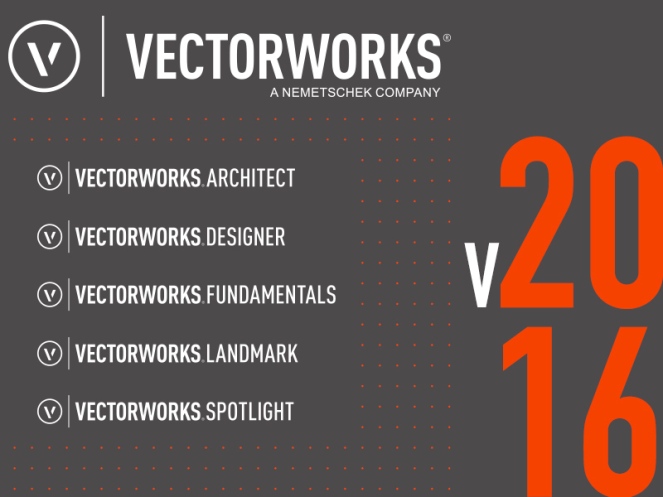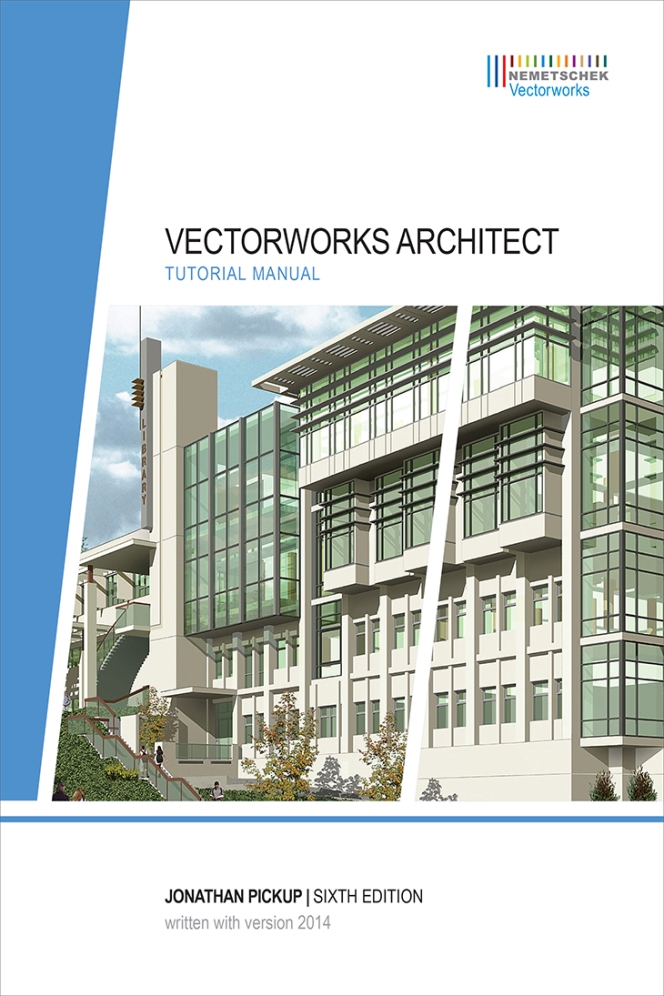Your Cart is Empty
Recent Articles
- Efficiency Meets Innovation: SketchUp 2024 Unveiled
- Maxon One Spring 2024 Release Packs Particle Power, Toon Shading, and More
- TurboCAD 2024 Unveiled by IMSI Design: Discover the New Features and Enhancements
- Exploring the Latest InfraWorks 2025 Updates
- Introducing the Latest Innovations in Autodesk's ReCap Pro 2025
- Discover the Latest Enhancements in Civil 3D 2025
- Exploring the Newest Features and Enhancements in Revit 2025
- Explore the Latest Features in Vantage 2.3 Update
- Explore the Latest AutoCAD 2025 Enhancements: Activity Insight, Smart Blocks, and Apple Silicon Support
- Unveiling Enscape 4.0: Revolutionizing Design with Unified Experience for macOS and Windows Users
Review of Vectorworks 2016
October 23, 2015 12 min read
Editor's Note: This is as good as it gets folks. John Helm's review of Vectorworks 2016 is the go to document to get a candid and thorough overview of the new Vectorworks release. John Helm is an Architect trained in California with more than 30 years of experience. He currently works with his partner, and Italian Architect wife, doing projects in Italy and California. Check out their website here. John has been using Vectorworks for over 15 years and writes a yearly review of each new update.
The views, opinions and positions expressed within guest posts are those of the author alone and do not represent those of Novedge.
2016 could be the best year yet for VECTORWORKS. There is one big addition to the software that might just make all the difference. In just about every review I have written, I have complained that it was still best suited for the small to medium firms due to its lack of file sharing. That is, it was possible but difficult for more than one person to work on a file at the same time. Here’s a quote from last year’s review:
The biggest item not addressed once again is how several designers work on a project at the same time. If you search the VECTORWORKS website you will find a nice little explanation of how to get multiple designers working on the same project. It can be done and those big firms in Japan where VECTORWORKS has captured most of the CAD market must be doing it successfully. But still it’s not easy. VECTORWORKS still in some ways seems to be a small shop tool. Perhaps they want to keep it that way so the parent company can sell its other products. But if they asked me, I’d tell them to spend the next year fixing this problem.
Well it looks like they took my advice. And they didn’t just make file sharing possible, they made it easy and intuitive just like most of all the VECTORWORKS features.
One hundred improvements
At VECTORWORKS they talk about 100 improvements. Of course these improvements are spread throughout the various disciplines that VECTORWORKS covers, so I will keep my focus on the major ones and especially those closer to my field of Architecture. Here is a short list taken from the VECTORWORKS' press pages:
- Project Sharing is an intuitive means for teams to communicate and collaborate while working concurrently on the same Vectorworks design file.
- Subdivision Modeling allows designers to transform primitive shapes like spheres and cube into any form imaginable.
- Marionette is the first and only cross-platform, Python®-based graphical scripting tool in the AEC, landscape and entertainment industries. Designers can create visual scripts that take advantage of Vectorworks software's 2D and 3D modeling capabilities, integrating seamlessly with BIM environments.
- Energos offers a dynamic, intelligent gauge of a building’s energy performance during the design process and is based on the Passivhaus calculation method.
- Point Cloud Support allows designers using their preferred 3D scanning device to capture a physical location and import a 3D point cloud object into Vectorworks software to manipulate and measure.
- Roof Components and Styles will interact with wall components ensure accuracy in the documentation of sections and elevations. Roof faces and roof objects now have the same component representation as walls and slabs, further extending the power of BIM.
- Landmark Site Modifier and Hardscape Tool Improvements help landscape professionals and urban planners design more efficiently and be more creative with pavements and walkways, including sloping hardscapes.
- Several New Features and Improvements in our Renderworks module include an upgraded MAXON Cinema 4D® render engine, Caustic Capabilities with refraction of light through translucent surfaces, Ambient Occlusion that adds depth to designs with more realistic shadowing and the New Grass Shader, as well as new camera effects, such as depth of field, exposure, vignette and bloom, allow for more realistic and striking visualizations and animations.
And here's my take on some of these new features:
-
The name
I believe that the parent company has recognized that file sharing is the beginning of a new era for Vectorworks. It makes sense that they have rebranded the product changing the name from Nemetschek Vectorworks to just VECTORWORKS. It now stands alone on its own merits.
-
Migration Manager
The first thing you will do when installing the new version is use the new Migration Manager command. What the Migration Manager does is automatically migrate custom workspaces, preferences, templates, favorite files, and libraries to the new upgraded version. This should be a welcome tool as it eliminates most of the tedious work of resetting everything when you install Vectorworks 2016.
-
File Sharing
From my initial look, it will make team work easy and fun. A social networking approach was taken, in which team members can communicate with each other while working on a team project. If you need extra layers, post a note and a team member can respond and make them happen. A complaint, which might turn out to be an advantage, is that individual objects cannot be checked out for work without checking out an entire layer. That’s what makes it intuitive; VECTORWORKS users are familiar with the layer setup so the team manager can easily assign layers to team members. I think that in the end, this will be less confusing than in Revit, where “work sets” can consist of just about any object.
-
Working Offsite
I immediately wondered if file sharing could also be used over the internet. My question was, could someone work on a project from home, or from another office, while others worked on it in the primary office? I could not really try this myself but here is a quote from Christiaan Briggs, “I’ve been using Project Sharing over a VPN between my home in London and our office in London, both on very good internet connections.The save and commits were quick (much much faster than WGR updates for instance). Very workable in my opinion. On a slower connection you might have to go get a cuppa tea but I suspect it would still be very workable.” I would say that this also opens up some great opportunities for smaller offices to joint venture on projects they could not do on their own. I can even imagine joint venturing with offices in other countries. Yeah, get your office working round the clock using different time zones. Sign me up!
-
Subdivision Modeling
No it’s not for modeling your latest tract house subdivision project. Take any shape and manipulate it until you have created that impossible to build shape that will get you fired either by your client or your boss. But think about how much fun you had doing it. I imagine Zaha Hadid wishes she had a copy of VECTORWORKS (maybe she does). This is one of those features that most Architects won’t get to use everyday, but it also shows the breadth of the program.Why not take the program home and design some cool toys for your kids that you can 3D print?  Things you can do with Surface Modeling.
Things you can do with Surface Modeling.
Design a chair as above to be 3D printed, or this 1960’s looking concrete free form structure from the VECTORWORKS demo video.
-
Marionette
This is one that brings a smile to my face. Marionette is the first industry, cross- platform, Python®–based scripting tool. Why am I smiling? It is because it will allow users to write a program that automates some repetitive activities within VECTORWORKS, without actually writing anything; just pick and choose from a list of predefined bits of script that appear in graphical form. Connect the pictures with lines and there you go; you’ve “written” your own little program. Architects who don't have time to learn how to code it's pretty awesome! Confession: I’m not totally sure how I would actually use it, but it seems a great feature and I’m sure the ideas will eventually arrive.  The image above is my attempt at using Marionette. First you connect the “Nodes” as shown, then “Wrap” them to make the block called Create Column (the Wrapper), then proceed to run it. Inputs of radius, height, etc. are input in the Object Info pallet of the “Wrapper”. There is a learning curve but it’s doable.
The image above is my attempt at using Marionette. First you connect the “Nodes” as shown, then “Wrap” them to make the block called Create Column (the Wrapper), then proceed to run it. Inputs of radius, height, etc. are input in the Object Info pallet of the “Wrapper”. There is a learning curve but it’s doable.
-
Point Cloud Support
Point cloud is the name given to various methods of 3D scanning of objects (which can be anything from a simple toy to a complex building). VECTORWORKS now allows the import of point clouds in several formats. The idea is that VECTORWORKS can use the imported images to manipulate and measure. This is great when working with existing buildings. The important thing to keep in mind is that the industry is going more and more virtual. With VECTORWORKS and most other BIM software the virtual walkthrough has been around for a while and as the software gets better so does the virtuality of the walkthrough. We can now combine our BIM model with real world scanned buildings and environments. The next step is the use of visualization goggles to let the viewer immerse himself in our architecture before it’s built. Next step after that is that we don’t even have to build it; just let the occupants imagine that it exists and interact virtually.
-
Energos
When we look at new features we have to look at those that are really new features not just changes or improvements to the existing program. Energos is just that. Saving energy is the hot topic these days. Energy calculations have been required in states like California for years and in Europe many countries are requiring all new construction to meet high standards of energy performance. So what could be better than a program that comes with VECTORWORKS and runs inside it, no need to export to an outside program? VECTORWORKS has everything the Designer or Architect needs to complete a design and present it. Here is a quote from the VECTORWORKS help file:
Energos is the integrated energy analysis component of the Vectorworks Architect program. With both graphical and numerical feedback based on the Passivhaus calculation method, Energos allows you to evaluate the energy performance of a building even if you are not an energy analysis professional. Easy-to-understand feedback will assist you in both the early design stages and as the building design evolves.
Of course there is a bit of work involved; your model must consist of elements that contain the information regarding energy consumption, heat loss or gain, etc. However, to make the job easier the program comes with some basic configurations for residential and non-residential building types.This image is a typical readout from Energos showing a performance level. 
-
Rendering/Renderworks
Renderworksis the rendering feature sold as an add on to the various versions. It’s a must have as most of the 3D rendering capabilities are lost without it. The question is, why design in 3D if you are not able to present your design in the best possible way? Renderworks is improved again this year, with an upgraded MAXON Cinema 4D® render engine. Some people will tell you that there are better choices for rendering, but seeing the quality of the images below, I think you don't need to look any further in order to produce spectacular photo realistic renderings.
 Renderworks samples from the VECTORWORKS website.
Renderworks samples from the VECTORWORKS website.
-
Horizontal Sections
Horizontal sections can be made using the clip cube. Basically when we turn on clip cube, a box is formed around the 3D model. If we select any one of the 6 surfaces we can move that surface through the building creating cut views. Selecting the top of the box and dragging it down we create horizontal cut views or sections as we move down. Stopping at any point we can then turn that view into a section, which is pretty slick and easy.  A Basic Horizontal Section with furniture, notes and dimensions could be added;
A Basic Horizontal Section with furniture, notes and dimensions could be added;  or and an Horizontal Section like this one. Lots of fun!
or and an Horizontal Section like this one. Lots of fun!
-
3D Modifiers for Slabs and Create Slab Style
This is a big deal. You could do this in the past by creating a slab and then combing or adding elements to an extruded polygon. But not much fun to be had. The new tool makes it much easier and you can even create slab styles for use on other projects. 
Slab Created with the 3D Slab Modifier Tool.
-
Symbols
They have been around for years, but every year they add more. This year is no exception. That is great in concept. However, the big groups of symbols all come un-rendered (they are grey with no texture). We might think that makes sense but it might be better to start with something that would look decent in a rendered view. There are two types: plug in objects which have parameters that are easily changed or symbols which require editing to change. If you use plugin objects you can select several and change the attributes of them all at the same time in the object info pallet; that's good. But if you use symbols, and there are many in say the cabinet symbols, you have to change each one individually. Since they consists of several pieces, that can be very time consuming. On the other hand, using plugins, means that we have to set the parameters before inserting, for each different configuration;and that is time consuming as well (unless the plugin is what we want to begin with). It would be better if we could select several symbols and change the common elements of them all at the same time.
-
People Props
Props are symbols made in such a way that when in 3D views, they always face the viewer. This is useful for making and placing objects in rendered views. Since they are 2D, they add very little to the file size. They are basically like props in a stage setting. I have made several using pictures of real people and have them for sale on my blog. On the blog you can also find past reviews of VECTORWORKS.
-
Vectorworks Service Select
This service gives you the best price and the first chance to get yearly upgrades. There are also other benefits like the following: Best Possible Price and Value. Guaranteed; Automatic and Hassle Free Software Upgrades; Exclusive On-Demand Learning; VIP Access to New Libraries, Textures, Plug-ins, and Templates; Discounts on Training and Services offered by Partners; Priority Technical Support; Easy Account Management.
I suppose this is a good thing. But I’m not that impressed by the idea that only subscribers get access to new libraries, textures, etc. It seems a bit unfair since most of them are provided by outside sources like manufacturers and don’t cost VECTORWORKS anything. And I’m not one to like the idea that if we buy a software program that works for us we should have to subscribe to a yearly upgrade in order to get add ons that will work just fine with our existing version. Of course this is not unique to VECTORWORKS, and this year they did include many that were exclusive last year.
-
Other changes and improvements in VECTORWORKS 2016
Here is a list of a few features that I have not covered, but that I think are nonetheless important. You can read about them on the VECTORWORKS' website.
Roof Joining, Linked Section Markers, Wall Styles, Roof Framing, Benchmark, Auto Scale,Door and Window Improvements, Stair Improvements ( woops they missed this one), Improved Autojoin Walls, Roof Component Styles, Section Elevation Marker, Story and Style Edit Menu.
Some VECTORWORKS Basics
They like to say that VECTORWORKS works the way Architects work. I have always agreed with this, in fact, this was the reason I began using it years ago. The best example of what I am talking about is how a project is finalized. In the pre CAD days we had sheets of paper with our drawings on them numbered and indexed. A finalized VECTORWORKS project is exactly the same: sheets, or sheet layers they call them, all numbered and laid out in a way that one can flip through to review a project all in one file. The work is done in design layers which are like sheets of translucent drafting paper which can be placed on top of each other to form a complete drawing. Elements of the drawing, like doors, windows, plumbing fixtures, etc., can be segregated in classes, which allow one to show them on the layer or not as needed. So just thinking logically, one can easily imagine, when creating a floor plan or foundation plan, what drawings or symbols need to be turned on or off. Then those plans are easily transferred to the sheets where they can be dragged, dropped, copied and pasted at will with scales, views, layers and classes changed as needed.
File Compatibility
VECTORWORKS is both a Mac and PC program so the files can go between them without issues. Many Architects are afraid of the interaction with AutoCAD, especially of having to cooperate with consultants who use it; they needn’t be. VECTORWORKS comes with a long list of import export options including, IFC, 3DS, Dwg etc, allowing one to move easily amongst the various popular CAD and BIM programs.
Training and Learning Vectorworks
I contend that anyone with experience using computer and other CAD programs, can pick up the basics and be productive with VECTORWORKS on their own in a few days. But there are online and onsite courses and perhaps the best way to train new hires or learn by oneself, is to get a copy of Jonathan Pickup’s Vectorworks Architect. He takes a step by step approach starting with the basics. If you spend a week going through all the exercises you will be good to go on just about any project. If you are really a newcomer to CAD start out with Vectorworks Essentials.
Pros
Easy to learn efficient to use.
One stop shopping program for anyone in the design business.
No need to learn and purchase 2 or 3 programs to get your work done.
File sharing is easy to use and learn.
Offsite file sharing is possible using VPN.
Energy analysis included in VECTORWORKS Architect.
Very reasonable price.
Allows cross over work from Architecture to Design to Lighting, Stage Design and Landscape Design.
Numerous import export options makes working with consultants using other programs easy.
Cons
Non plug in symbols cannot be modified in batches.
No multi view screens.
Relatively low user base.
Limited job opportunities in the Architecture Industry.
Conclusions
I have not attempted to touch on all the features of VECTORWORKS but to discuss a few of the changes and additions in the latest upgrade. As far as I can see nothing has been taken away and only new stuff added. So have a look at my previous reviews for more discussion of other features. This year’s issue has made some really big changes which will make it an absolute purchase or upgrade for any but the one man office. VECTORWORKS is a well-rounded program which is easy to learn. Now with the added file sharing, it is really complete. Browse for user reviews on the internet and discover how people have picked it up and been productive in just a few days of self-study. The Designer series comes with a full set of packages, Lighting and Set Design, Landscape Design, Architecture and just Design in general. Use it to design a poster, a chair, a tool or a cathedral. In today’s world where we all have to at least be prepared to move sideways in our careers, what could be better than knowing how to use a program that can go along with us?
Disclaimer
I like and have used VECTORWORKS for years in my architectural practice. I would like to see more people using it; I have not had a lot of experience with other programs and I am not capable of or willing to say other programs are better or worse. I was also given a free copy so that I could write this review.
John Helm
To find out more about John Helm check out his website and his blog. For everything VECTORWORKS check out Novedge.
Related articles
Also in NOVEDGE Blog

Maxon One Spring 2024 Release Packs Particle Power, Toon Shading, and More
April 10, 2024 4 min read
Read More
TurboCAD 2024 Unveiled by IMSI Design: Discover the New Features and Enhancements
April 10, 2024 2 min read
Read MoreSubscribe
Sign up to get the latest on sales, new releases and more …






